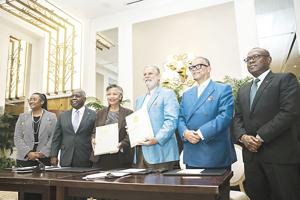DAVAO CITY — The University of Mindanao (UM) has launched a state-of-the-art laboratory for synthetic biology and metabolic engineering. The UM Biomolecular Engineering Laboratory (UMBEL), located inside the UM Bolton Campus, is one of the first laboratories in the Philippines to conduct research on synthetic biology and metabolic engineering. It was established mainly through expert assistance from Dr.
Angelo B. Bañares, a short-term “Balik Scientist” under the Department of Science and Technology (DOST)’s Balik Scientist Program (BSP). The P8-million facility funded by the UM is dedicated to advancing studies to address pressing environmental issues through the study of non-pathogenic microorganisms.

Excessive reliance on non-renewable resource During his Exit Report Presentation as Balik Scientist held before the inauguration of the UMBEL, Bañares said that as much as 10 billion tons of fossil fuel is used yearly in the production of various products, driving climate change due to carbon dioxide emission. “If you trace the products we use every day like clothes and medicine, you will find that they were made using oil or fossil fuel. For instance, two-thirds of our clothing comes from fossil fuel,” he explained.
Subsequently, 80 percent of these clothes will later end up in a landfill, making the clothing industry one of the most polluting industries in the world. However, “we do not need to rely on fossil fuel anymore,” Bañares said. Rather than using a non-renewable resource, “we can use microorganisms as nature’s chemical factories to produce the needed molecules for our industries,” he further said.
How synthetic biology is changing the world? The United States National Human Genome Research Institute defines synthetic biology as a field of science that involves redesigning organisms for useful purposes by engineering them to have new abilities. Banares explained that this is achieved by “editing and redesigning the biological components, systems, and interactions that make up life.” In simple terms, an organism — such as bacteria — is redesigned to produce a substance, such as vaccines, or to gain a new ability, such as sensing something in the environment.
Among the novel products of synthetic biology include the modified rice that produce beta-carotene to prevent vitamin A deficiency, which causes blindness in as much as 500,000 children every year and increases their risk of death from infectious diseases, as well as the yeast engineered to produce rose oil as an eco-friendly and sustainable substitute for real roses used in the production of luxury scents. Meanwhile, metabolic engineering is “the improvement of cellular activities by manipulation of enzymatic, transport, and regulatory functions of the cell with the use of recombinant DNA technology,” meaning, it involves altering the metabolic pathways within a cell to enhance the production of target compounds, such as lipid, for instance. DNA or deoxyribonucleic acid is a molecule considered as the building block of all living things because it contains the genetic information necessary in building and maintaining an organism.
Often, metabolic engineering is used to produce valuable substances like pharmaceuticals on an industrial scale in a cost-effective manner. Promising market The synthetic biology market is projected to grow from $10 billion in 2021 to as much as $37 to $100 billion by 2030. This was driven by significant milestone in 2019 when scientists created a living organism with entirely human-made DNA and the development of synthetic organisms for potential “living therapeutics” in 2021 using engineered human or microbial cells to treat diseases before degradation.
A 2016 report, which examined technological advancements poised to significantly benefit the planet’s future, compiled by the World Economic Forum’s Meta-Council on Emerging Technologies, published in partnership with Scientific American, listed systems metabolic engineering as one of the top 10 emerging technologies during the said year. “So, this particular technology, in fact, already took off in advanced economies, but still new in the Philippines,” Bañares said. Bañares shared that when he previously served as a judge in the International Genetically Engineered Machine (IGEM) competition.
He was surprised that “there were contestants from other Southeast Asian countries like Indonesia, Thailand, and Malaysia but none from the Philippines.” Thus, when he was approached by Dr. Chosel P.
Lawagon, director of UM’s Institute of Emerging Technology, a fellow alumnus of Myongyi University in South Korea, he was motivated to collaborate with fellow Balik Scientists to establish the UMBEL because of the potential of Filipino researchers and students. Expertise as Balik Scientist Bañares received his doctorate in Energy Science and Technology from Myongyi University in South Korea, where he majored in synthetic biology and metabolic engineering. Additionally, he gained experience working as a researcher in South Korea’s Department of Energy Science and Technology, where he carried out a variety of research projects.
He received an award for his study on the application of a novel promoter for a certain metabolic pathway in bacteria. Bañares also co-owns a number of patents in South Korea and the United States for novel approach Before returning to the country as a Balik Scientist, Bañares was employed as a researcher at the French National Research Institute for Agriculture, Food, and the Environment and the Micalis Institute in France. Host institution crucial to BSP success DOST undersecretary for research and development Leah Buendia highlighted the UM’s willingness and commitment to learn and perform research studies.
“Not all universities have the open-mindedness to host a Balik Scientist,” Buendia said. She said UM is currently hosting three Balik Scientists, each with their own area of expertise who collaborated to set up the UMBEL. This facilitated the realization of UM’s goal to establish the modern laboratory, she said.
In her opening message, Ñinaliza Escorial, deputy executive director of the Philippine Council for Industry, Energy, and Emerging Technologies Research and Development (PCIEERD), stated that the BSP previously caters to public research institutions. The program was expanded to include the private sector and even local government units. UM president and chief executive officer Dr.
Guillermo Torres Jr. cited the DOST for extending its assistance to the private sector and for the expertise provided by Balik Scientists. “Initially, we intended the laboratory as a Covid-19 testing facility,” Torres shared.
However, they encountered some setbacks in the process of acquiring the necessary approval from the government. “Because the pandemic is over, I decided to donate the equipment to our research department.” And so, the idea of establishing the UMBEL was conceptualized, he said.
Safety concern Recent advances in biotechnology and computation accelerated the application of bioengineering because of its huge benefits. However, it also raised concerns over safety and security, as well as ethical concerns. Bañares assured that harmful microorganisms are not involved in the process.
“Only non-pathogenic organisms are used in their laboratory. Because we work with Escherichia (E.) coli bacteria, people are fearful because they think it is harmful,” he said.
But Bañares explained that “there are certain strains, such as E. coli K-12, that is relatively safe and cannot cause disease” as it is a defective pathogen. Nonetheless, Bañares facilitated the establishment of the Institutional Biosafety Committee that even includes community representatives and put in place the required protocols in handling all kinds of microorganisms.
What’s next for UMBEL? Now that the facilities were completed in UMBEL, the team is in the process of acquiring the needed reagents to fully operationalize. While waiting for the said materials from abroad, which may take time given the procurement process, Bañares and fellow Balik Scientists are conducting hands-on training, such as Real-Time PCR and plasmid engineering, to better equip researchers and theses students in the field of bioengineering. According to Lawagon, “our priority at the moment is to focus on products to help our agricultural sector, such as the banana industry, which is an export commodity of Davao.
“We already have initial talks with a banana company for a research partnership and hope for our partnership to materialize once we acquire the reagents and other needed materials,” Lawagon said. Further, their interests also include bioremediation to accelerate degradation of agricultural wastes, as well as development of cost-effective biosensors to detect toxic heavy metals and chemical pollutants and possibly convert them into specialty and high-value chemicals. Challenges and concerns Bañares lamented on the challenges he encountered as a Balik Scientist during his presentation.
He emphasized the country’s procurement process, which he described as “excruciating slow”, causes significant delay in the conduct of research. He suggested streamlining the procedure by adopting more efficient and transparent systems and establishing a dedicated procurement team within the Bureau of Customs to expedite the process for research-related materials. Further, other issues he identified include constraint in skill and knowledge transfer process, particularly if the field is new, which require more time for foundation learning, excessive teaching load of Balik Scientists that detracts them from focusing on other critical activities, such as research, scarcity of research centers and facilities, and lack of research networks.
To sustain and maximize the UMEBL’s services, Buendia assured that the DOST is fully committed to support the initiative. She pushed Bañares to apply as a long-term Balik Scientist and become a regular staff of the university and for the team to submit more research proposals for funding by the department..



















